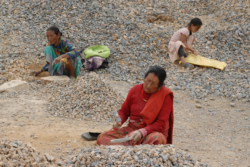What does ‘Just Transition’ look like through a feminist lens?

Erika Moranduzzo, PhD candidate at the School of Law, discusses how current just transition plans for a greener economy often fail to address deep-rooted inequalities.
While just transition pathways are working towards a transition to a greener planet, we have to question how ‘just’ and ‘fair’ this can truly be, when structural patterns of workforce segregation experienced by women and people from ethnic minorities or indigenous communities continue to exist in the workplace.
Just transition, is defined by the International Labour Organization (ILO) as “Greening the economy in a way that is as fair and inclusive as possible to everyone concerned, creating decent work opportunities and leaving no one behind”. As part of the climate commitments, countries around the world have agreed on implementing just transition pathways to a climate-neutral economy that is fair and inclusive, thus being able to create green decent job opportunities for all. Parts of the world, such as Canada and the EU, have already started designing, planning, and implementing their just transition programs to transition away from fossil fuel to renewable energy in order to achieve climate neutrality by 2050.
While these initiatives must be praised as they are a step forward toward the achievement of the Paris Agreement goal of keeping the temperature well below 2°C, they also raise questions about their capacity to green the workforce by leaving no one behind. The main question is whether those plans and programs are fair and inclusive for everyone. Unfortunately, this is not the case.
According to a recent report of the Working Group on Human Rights and Transitional Corporations and other business enterprises 2023, most of the just transition programs examined perpetuate pre-existing patterns of socio-economic exclusion that characterized the fossil fuel sector. In particular, it was pointed out that the new green economy envisioned in the just transition programs is still strongly male-norm dominated. Canada, for instance, appears to have shaped its own plan around the needs of white-male full-time workers, neglecting the other categories of workers involved in the mining sector and related ones (retail and health care), in particular women and those belonging to indigenous communities. Similar problems have been raised in relation to the EU Green Deal.
Overall, such plans do not appear to engage with social justice demands that require questioning the structural conception of the working environment based on gender and discriminatory stereotypes. Consequently, the just transition plans do not solve the structural patterns of workforce segregation experienced by women and people from ethnic minorities or indigenous communities.

How can these social injustices be confronted and addressed within the framework of just transitions? Simply mentioning the importance of gender equality is insufficient. Therefore, a more piercing conception of equality is required. Sandra Fredman, a social justice theorist, proposes a feminist approach to solve the problem. According to the proposed feminist approach, the right to substantive gender equality entails simultaneously addressing four dimensions:
- The redistributive dimension: redressing gendered disadvantage by levelling up the position and conditions of women in all their diversities in the working environment
- The recognition dimension (ie, addressing stigma, stereotyping, prejudice, and violence) by adopting a broad definition of work able to include both formal and informal work (including the caregiving sector)
- The participative dimension: facilitating women’s voice and participation
- The transformative dimension: accommodating difference and achieving structural change by dismantling the sexist/racist structures embedded in the working environment.
Only through a feminist approach is it possible to achieve a fair and just green transition. At COP29 I would like to see a better and meaningful engagement of the Parties with multidimensional (intersectional) substantive equalities issues as requested by UN Special Rapporteurs as well as the adoption of a gender-transformative approach to climate justice issues as suggested by the W7 in its Communiqué to G7 Leaders. Conversely, a lack of engagement with social justice issues will only lead to a transition towards a greener workforce, but not a fairer or more just one.
Read about Erika’s participation in the W7 at this year’s G7 Summit in Italy.
Written by Erika Moranduzzo, PhD researcher from the School of Law.
Featured image from the Scottish Women’s Budget Group (SWBG)
Article image: “Nepalese women working at quarry” by ILO in Asia and the Pacific is licensed under CC BY-NC-ND 2.0.




